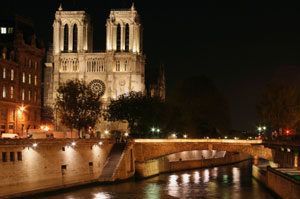Paris,
France, is known for iconic structures. The
Eiffel Tower, the Arc de Triomphe, and the dome of Sacre Coeur on Montmartre are practically clichés when thinking of the City of Light. Perhaps no one building more perfectly encapsulates the city's soul as the Cathedral of Notre Dame de Paris, located on Ile-de-la-Cite in the River Seine. This splendid example of Gothic architecture occupies a site that's long been the center of the city and captures in its soaring arches and stained glass windows much that is emblematic of the French soul.Notre Dame's site has long been a center for worship, long before the advent of Christianity in France. Celtic tribes had sacred groves of trees on the island. When the area was part of the Roman Empire, a temple to Jupiter graced the site; after the triumph of Christianity, two separate churches in the Romanesque style were built over the centuries, with the most recent being the Cathedral de Saint-Etienne (St. Stephen) in the year 528.In order to accommodate a growing population, that cathedral was demolished in 1160, some six hundred years after it was built, on the orders of Maurice de Sully, Bishop of Paris. Legend says that he sketched the cathedral plans in the dirt outside of the rubble and decreed that it would be dedicated to the Virgin Mary (Notre Dame, or 'Our Lady'). Construction on the current structure did not begin until 1163 and was not completed until 1345, 182 years later.

The cathedral is a classic example (some would say the classic example) of the Gothic style, which dominated much sacred and secular architecture during this time period. Gothic architecture is known for its verticality and for its use of certain stylistic elements, including the Gothic arch (characterized by the points at the top) and the flying buttress, an external arch that supports the weight of the building from the outside and allows for much taller walls. Since there is less need for thick walls at the base to support their own weight, the walls can be much taller, lending an air of spaciousness and light to the interior.The floor plan of Notre Dame, like most Gothic churches, takes the form of a cross. The long central area of the cross, called the nave, is impressive in its size: 427 ft (130 m) long by 157 ft (48 m) large by 115 ft (35 m) high. The pillars that line the double aisles on either side of the nave are up to 16 ft (5 m) in diameter. The arms of the cross are called the 'transept.'Notre Dame's spared towers (also a hallmark of Gothic architecture) towers are 226 ft (69 m) high. For a view of Paris and the overall structure, one can climb the 368 stairs are required to access the top. The south tower houses the bell made famous in the Victor Hugo Story 'The Hunchback of Notre Dame.' Originally installed in 1400, the bell was recast in 1631 and is now only rung on special occasions. Notre Dame holds other well-known decorative elements, one of which is the presence of gargoyles. These grotesque statues perch in niches on the cathedral walls, where they serve a practical purpose: they conceal the mouths of drainpipes that divert water out away from the masonry of the walls. Superstition holds that the fanciful gargoyles (the word comes from a Latin word meaning 'gullet' or 'drain') are carved as half-men, half-beasts that steer demons away from the building. Another feature of the cathedral is the abundance of richly colored stained glass windows. In a time when many of the cathedral's patrons were illiterate, the windows of the church were used to illustrate and explain Biblical stories. The only original windows in the cathedral are the two 'rose windows;' the other windows have been replaced over the centuries. During the 18th century, many of the windows were replaced with clear window glass by architectural reformers who attempted to give the building a cleaner, more classical look; however, stained glass windows were returned to their rightful places by 1860. The original rose windows were removed and stored during World War Two to prevent them from being damaged by the Nazi bombardments. After the war, they were cleaned and restored before being returned to their positions.Over the centuries, the Cathedral of Notre Dame de Paris has been the site of many important ceremonies. Crusaders headed for the Holy Land after praying in Notre Dame, and in fact, the Third Crusade was launched from the cathedral. During the French Revolution, the revolutionaries' anti-clerical fervor led to the building being rechristened 'The Temple of Reason;' the interior was used as a food warehouse. Napoleon crowned himself Emperor of France in the Cathedral in 1804 while installing his wife Josephine as Empress. Pope Pius VII attended the ceremony.During the unrest of the Commune of 1871, the church came under attack by revolutionaries who allegedly burned a huge pile of wooden chairs in the interior of the building. Fortunately, the cathedral survived the inferno unscathed.Today, Notre Dame is a public building operated by the French government. Religious occasions still happen in the church on occasion (a recent example being the funeral of the former Archbishop of Paris). Over 6,000 worshippers can fill the church for these events. IIts primary function is a unique and magnificent attraction for the tens of thousands of tourists who visit annually, seeking a connection to the glory that is French history and the splendor that came from the Middle Ages' faith.